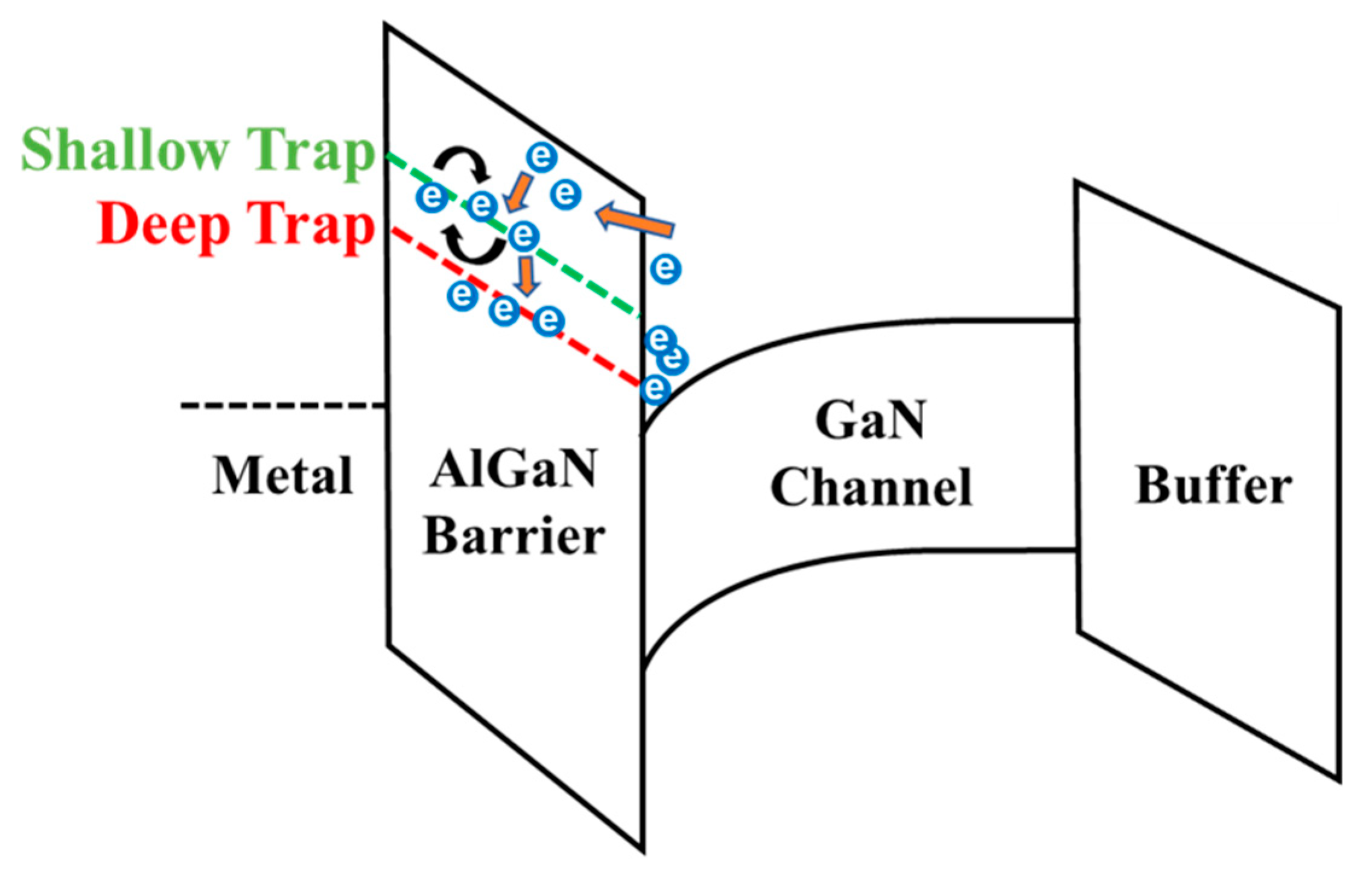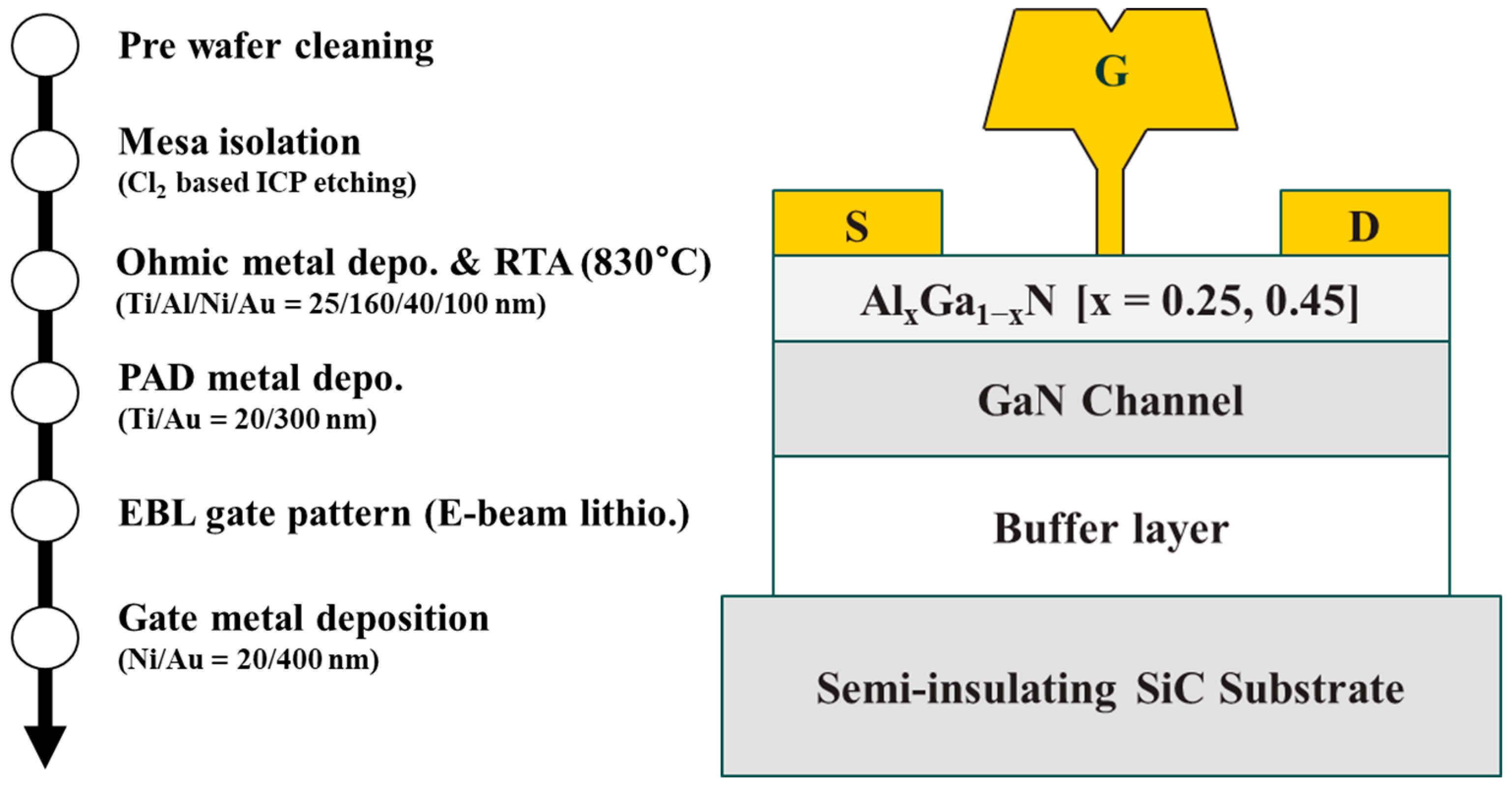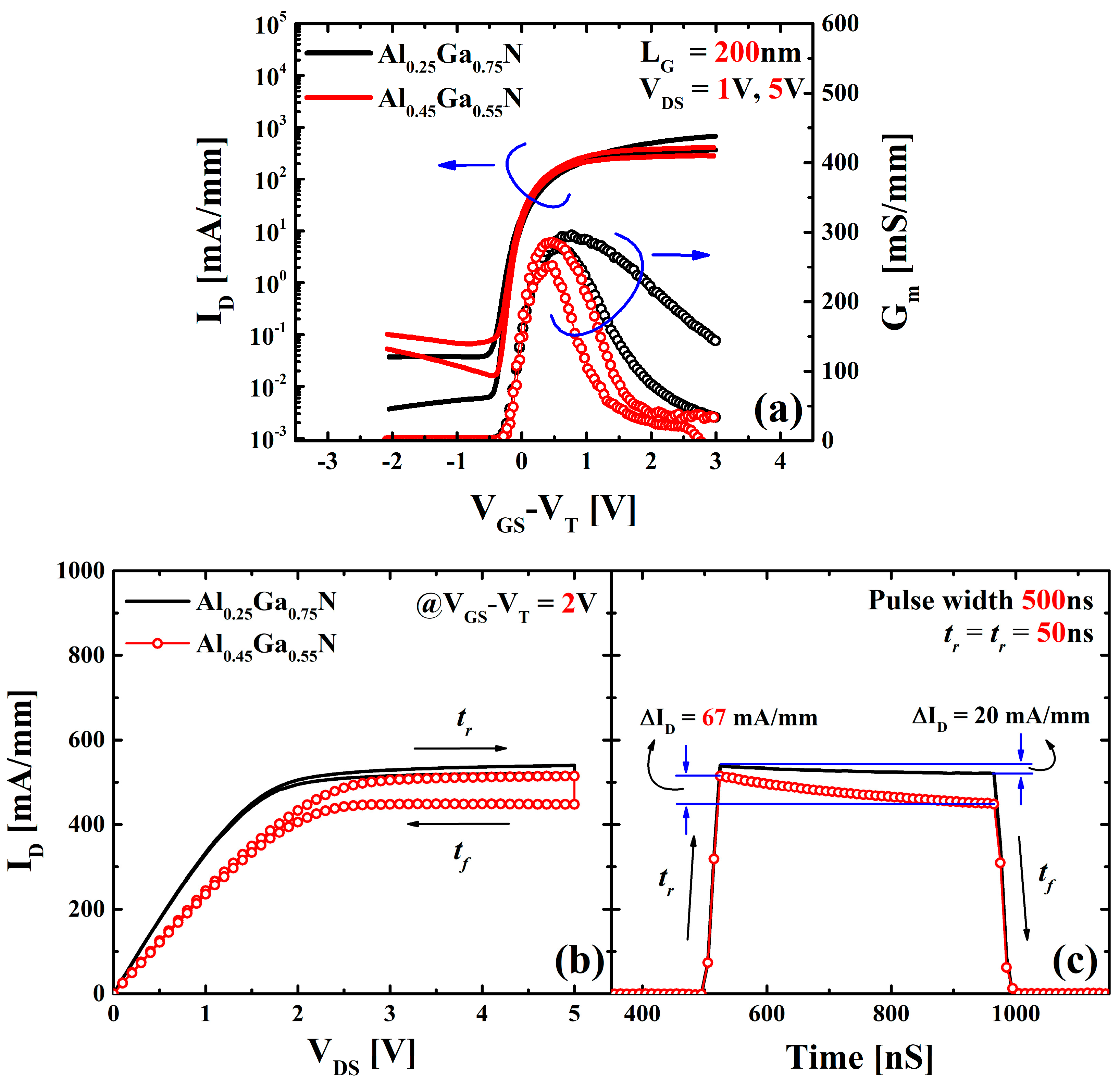Impact of Charge-Trapping Effects on Reliability Instability in AlxGa1−xN/GaN High-Electron-Mobility Transistors with Various Al Compositions
Abstract
1. Introduction
2. Experimental Details
3. Results and Discussion
3.1. Charge-Trapping Analysis with Pulsed I–V
3.2. Charge-Trapping Analysis with Constant Voltage Stress Condition
3.3. Quantitative Analysis of Trap Density with 1/f Low-Frequency Noise
4. Conclusions
Author Contributions
Funding
Data Availability Statement
Conflicts of Interest
References
- Del Alamo, J.A. Nanometre-Scale Electronics with III–V Compound Semiconductors. Nature 2011, 479, 317–323. [Google Scholar] [CrossRef] [PubMed]
- Baek, J.-M.; Kim, H.-J.; Yoo, J.-H.; Shin, J.-W.; Shin, K.-Y.; Amir, W.; Ju, G.; Kim, H.-J.; Oh, J.; Kim, H.; et al. Vertical Homo-Junction In0.53Ga0.47As Tunneling Field-Effect Transistors with Minimum Subthreshold Swing of 52 MV/Decade. Solid-State Electron. 2022, 197, 108447. [Google Scholar] [CrossRef]
- Shin, K.Y.; Shin, J.W.; Chakraborty, S.; Amir, W.; Shin, C.S.; Kim, T.W. Trap Behavior of Metamorphic HEMTs with Pulsed IV and 1/f Noise Measurement. In Proceedings of the European Solid-State Device Research Conference, Milan, Italy, 19–22 September 2022; Volume 2022, pp. 324–327. [Google Scholar] [CrossRef]
- Sheppard, S.T.; Doverspike, K.; Pribble, W.L.; Allen, S.T.; Palmour, J.W.; Kehias, L.T.; Jenkins, T.J. High-Power Microwave GaN /AlGaN HEMT’s on Semi-Insulating Silicon Carbide Substrates. IEEE Electron Device Lett. 1999, 20, 161–163. [Google Scholar] [CrossRef]
- Brown, D.F.; Williams, A.; Shinohara, K.; Kurdoghlian, A.; Milosavljevic, I.; Hashimoto, P.; Grabar, R.; Burnham, S.; Butler, C.; Willadsen, P.; et al. W-Band Power Performance of AlGaN/GaN DHFETs with Regrown N+ GaN Ohmic Contacts by MBE. In Proceedings of the IEEE International Electron Devices Meeting (IEDM), Washington, DC, USA, 5–7 December 2011; pp. 461–464. [Google Scholar] [CrossRef]
- Shinohara, K.; Milosavljevic, I.; Burnham, S.; Cornon, A.; Hashimoto, P.; Wong, D.; Hu, M.; Butler, C.; Schmitz, A.; Willadsen, P.J.; et al. 60-Nm GaN/AlGaN DH-HEMTs with 1.0 Ω·mm Ron, 2.0 A/Mm Idmax, and 153 GHz FT. In Proceedings of the Device Research Conference—Conference Digest, DRC, University Park, PA, USA, 22–24 June 2009; pp. 167–168. [Google Scholar]
- Shi, J.; Eastman, L.F.; Xin, X.; Pophristic, M. High Performance AlGaN/GaN Power Switch with HfO2 Insulation. Appl. Phys. Lett. 2009, 95, 7–10. [Google Scholar] [CrossRef]
- Liu, Z.H.; Ng, G.I.; Arulkumaran, S.; Maung, Y.K.T.; Teo, K.L.; Foo, S.C.; Sahmuganathan, V. Improved Linearity for Low-Noise Applications in 0.25-Μm GaN MISHEMTs Using ALD Al2O3 as Gate Dielectric. IEEE Electron Device Lett. 2010, 31, 803–805. [Google Scholar] [CrossRef]
- Chakraborty, S.; Kim, T.W. Comprehensive Schottky Barrier Height Behavior and Reliability Instability with Ni/Au and Pt/Ti/Pt/Au on AlGaN/GaN High-Electron-Mobility Transistors. Micromachines 2022, 13, 84. [Google Scholar] [CrossRef]
- Mimila-Arroyo, J.; Jomard, F.; Chevallier, J. Improvement of AlGaN/GaN/Si High Electron Mobility Heterostructure Performance by Hydrogenation. Appl. Phys. Lett. 2013, 102, 092104. [Google Scholar] [CrossRef]
- Amir, W.; Shin, J.W.; Chakraborty, S.; Shin, K.Y.; Hoshi, T.; Tsutsumi, T.; Sugiyama, H.; Kwon, H.M.; Kim, T.W. Instability Assessment of AlGaN/GaN High Electron Mobility Transistors Under High Drain Current Condition. In Proceedings of the Asia-Pacific Microwave Conference (APMC 2022), Yokohama, Japan, 29 November–2 December 2022; pp. 184–186. [Google Scholar] [CrossRef]
- Chakraborty, S.; Amir, W.; Shin, J.W.; Shin, K.Y.; Cho, C.Y.; Kim, J.M.; Hoshi, T.; Tsutsumi, T.; Sugiyama, H.; Matsuzaki, H.; et al. Explicit Thermal Resistance Model of Self-Heating Effects of AlGaN/GaN HEMTs with Linear and Non-Linear Thermal Conductivity. Materials 2022, 15, 8415. [Google Scholar] [CrossRef]
- Chakraborty, S.; Shin, J.W.; Amir, W.; Shin, K.Y.; Kim, T.W. An Explicit Thermal Resistance Model Regarding Self-Heating Effect of AlGaN/GaN High Electron Mobility Transistor. Mater. Sci. Forum 2022, 1074, 125–131. [Google Scholar] [CrossRef]
- Rossetto, I.; Meneghini, M.; Tajalli, A.; Dalcanale, S.; De Santi, C.; Moens, P.; Banerjee, A.; Zanoni, E.; Meneghesso, G. Evidence of Hot-Electron Effects during Hard Switching of AlGaN/GaN HEMTs. IEEE Trans. Electron Devices 2017, 64, 3734–3739. [Google Scholar] [CrossRef]
- Duan, M.; Zhang, J.F.; Ji, Z.; Zhang, W.; Kaczer, B.; De Gendt, S.; Groeseneken, G. Defect Loss: A New Concept for Reliability of MOSFETs. IEEE Electron Device Lett. 2012, 33, 480–482. [Google Scholar] [CrossRef]
- Chaudhry, A.; Kumar, M.J. Controlling Short-Channel Effects in Deep-Submicron SOI MOSFETs for Improved Reliability: A Review. IEEE Trans. Device Mater. Reliab. 2004, 4, 99–109. [Google Scholar] [CrossRef]
- Amir, W.; Kim, D.H.; Kim, T.W. Comprehensive Analysis of Quantum Mechanical Effects of Interface Trap and Border Trap Densities of High-k Al2O3/In0.53Ga0.47As on a 300-Mm Si Substrate. IEEE Access 2020, 8, 211464–211473. [Google Scholar] [CrossRef]
- Kwon, H.M.; Kim, D.H.; Kim, T.W. Impact of Fast and Slow Transient Charging Effect on Reliability Instability in In0.7Ga0.3As Quantum-Well MOSFETs with High-κ Dielectrics. Jpn. J. Appl. Phys. 2020, 59, 110903. [Google Scholar] [CrossRef]
- Amir, W.; Shin, J.; Shin, K.; Chakraborty, S.; Cho, C.; Kim, J.; Lee, S.; Hoshi, T.; Tsutsumi, T.; Sugiyama, H.; et al. Performance Enhancement of AlGaN/GaN HEMT via Trap-State Improvement. IEEE Trans. Electron Devices 2023, 170, 2988–2993. [Google Scholar] [CrossRef]
- Ioannidis, E.G.; Dimitriadis, C.A.; Haendler, S.; Bianchi, R.A.; Jomaah, J.; Ghibaudo, G. Improved Analysis and Modeling of Low-Frequency Noise in Nanoscale MOSFETs. Solid-State Electron. 2012, 76, 54–59. [Google Scholar] [CrossRef]
- Young, C.D.; Zhao, Y.; Heh, D.; Choi, R.; Lee, B.H.; Bersuker, G. Pulsed Id-Vg Methodology and Its Application to Electron-Trapping Characterization and Defect Density Profiling. IEEE Trans. Electron Devices 2009, 56, 1322–1329. [Google Scholar] [CrossRef]
- Bersuker, G.; Zeitzoff, P.; Sim, J.H.; Lee, B.H.; Choi, R.; Brown, G.; Young, C.D. Mobility Evaluation in Transistors with Charge-Trapping Gate Dielectrics. Appl. Phys. Lett. 2005, 87, 2003–2006. [Google Scholar] [CrossRef]
- Heh, D.; Young, C.D.; Choi, R.; Bersuker, G. Extraction of the Threshold-Voltage Shift by the Single-Pulse Technique. IEEE Electron Device Lett. 2007, 28, 734–736. [Google Scholar] [CrossRef]
- Heh, D.; Young, C.D.; Brown, G.A.; Hung, P.Y.; Diebold, A.; Bersuker, G.; Vogel, E.M.; Bernstein, J.B. Spatial Distributions of Trapping Centers in HfO2/SiO2 Gate Stacks. Appl. Phys. Lett. 2006, 88, 152907. [Google Scholar] [CrossRef]
- Bersuker, G.; Sim, J.H.; Park, C.S.; Young, C.D.; Nadkarni, S.V.; Choi, R.; Lee, B.H. Mechanism of Electron Trapping and Characteristics of Traps in HfO2 Gate Stacks. IEEE Trans. Device Mater. Reliab. 2007, 7, 138–145. [Google Scholar] [CrossRef]
- Bersuker, G.; Park, C.S.; Barnett, J.; Lysaght, P.S.; Kirsch, P.D.; Young, C.D.; Choi, R.; Lee, B.H.; Foran, B.; Van Benthem, K.; et al. The Effect of Interfacial Layer Properties on the Performance of Hf-Based Gate Stack Devices. J. Appl. Phys. 2006, 100, 094108. [Google Scholar] [CrossRef]
- Young, C.D.; Zeitzoff, P.; Brown, G.A.; Bersuker, G.; Lee, B.H.; Hauser, J.R. Intrinsic Mobility Evaluation of High-Κ Gate Dielectric Transistors Using Pulsed Id-Vg. IEEE Electron Device Lett. 2005, 26, 586–589. [Google Scholar] [CrossRef]
- Young, C.D.; Heh, D.; Neugroschel, A.; Choi, R.; Lee, B.H.; Bersuker, G. Electrical Characterization and Analysis Techniques for the High-κ Era. Microelectron. Reliab. 2007, 47, 479–488. [Google Scholar] [CrossRef]
- Cho, M.; Lee, J.D.; Aoulaiche, M.; Kaczer, B.; Roussel, P.; Kauerauf, T.; Degraeve, R.; Franco, J.; Ragnarsson, L.Å.; Groeseneken, G. Insight into N/PBTI Mechanisms in Sub-1-Nm-EOT Devices. IEEE Trans. Electron Devices 2012, 59, 2042–2048. [Google Scholar] [CrossRef]
- Hung, K.K.; Ko, P.K.; Hu, C.; Cheng, Y.C. A Unified Model for The Flicker Noise In Metal-Oxide-Semiconductor Field-Effect Transistors. IEEE Trans. Electron Devices 1990, 37, 654–665. [Google Scholar] [CrossRef]
- Ghibaudo, G.; Roux, O.; Nguyen-Duc, C.; Balestra, F.; Brini, J. Improved Analysis of Low Frequency Noise in Field-Effect MOS Transistors. Phys. Status Solidi 1991, 124, 571–581. [Google Scholar] [CrossRef]
- Han, I.S.; Kwon, H.M.; Bok, J.D.; Kwon, S.K.; Jung, Y.J.; Choi, W.I.; Choi, D.S.; Lim, M.G.; Chung, Y.S.; Lee, J.H.; et al. Effect of Nitrogen Concentration on Low-Frequency Noise and Negative Bias Temperature Instability of p-Channel Metal-Oxide-Semiconductor Field-Effect Transistors with Nitrided Gate Oxide. Jpn. J. Appl. Phys. 2011, 50, 12–16. [Google Scholar] [CrossRef]
- Amir, W.; Shin, J.W.; Shin, K.Y.; Kim, J.M.; Cho, C.Y.; Park, K.H.; Hoshi, T.; Tsutsumi, T.; Sugiyama, H.; Matsuzaki, H.; et al. A Quantitative Approach for Trap Analysis between Al0.25Ga0.75N and GaN in High Electron Mobility Transistors. Sci. Rep. 2021, 11, 22401. [Google Scholar] [CrossRef]
- Nanowire, G.; Bae, Y.; Ghibaudo, G.; Cristoloveanu, S. 1/f-Noise in AlGaN/GaN Nanowire Omega-FinFETs. IEEE Electron Device Lett. 2017, 38, 252–254. [Google Scholar]
- Vodapally, S.; Theodorou, C.G.; Bae, Y.; Ghibaudo, G.; Cristoloveanu, S.; Im, K.-S.; Lee, J. Comparison for 1/f Noise Characteristics of AlGaN/GaN FinFET and Planar MISHFET. IEEE Trans. Electron Devices 2017, 64, 3634–3638. [Google Scholar] [CrossRef]
- Yin, R.; Li, Y.; Sun, Y.; Wen, C.P.; Hao, Y.; Wang, M. Correlation between Border Traps and Exposed Surface Properties in Gate Recessed Normally-off Al2O3/GaN MOSFET. Appl. Phys. Lett. 2018, 112, 2–7. [Google Scholar] [CrossRef]






| Sample | ∆ID [mA/mm] | n | ℽ | Nt [cm−3·eV−1] |
|---|---|---|---|---|
| Al0.25Ga0.75N/GaN | 20 | 0.17 | 1 | 1.8 × 1019 |
| Al0.45Ga0.55N/GaN | 67 | 0.21 | 1.3 | 3 × 1019 |
Disclaimer/Publisher’s Note: The statements, opinions and data contained in all publications are solely those of the individual author(s) and contributor(s) and not of MDPI and/or the editor(s). MDPI and/or the editor(s) disclaim responsibility for any injury to people or property resulting from any ideas, methods, instructions or products referred to in the content. |
© 2023 by the authors. Licensee MDPI, Basel, Switzerland. This article is an open access article distributed under the terms and conditions of the Creative Commons Attribution (CC BY) license (https://creativecommons.org/licenses/by/4.0/).
Share and Cite
Amir, W.; Chakraborty, S.; Kwon, H.-M.; Kim, T.-W. Impact of Charge-Trapping Effects on Reliability Instability in AlxGa1−xN/GaN High-Electron-Mobility Transistors with Various Al Compositions. Materials 2023, 16, 4469. https://doi.org/10.3390/ma16124469
Amir W, Chakraborty S, Kwon H-M, Kim T-W. Impact of Charge-Trapping Effects on Reliability Instability in AlxGa1−xN/GaN High-Electron-Mobility Transistors with Various Al Compositions. Materials. 2023; 16(12):4469. https://doi.org/10.3390/ma16124469
Chicago/Turabian StyleAmir, Walid, Surajit Chakraborty, Hyuk-Min Kwon, and Tae-Woo Kim. 2023. "Impact of Charge-Trapping Effects on Reliability Instability in AlxGa1−xN/GaN High-Electron-Mobility Transistors with Various Al Compositions" Materials 16, no. 12: 4469. https://doi.org/10.3390/ma16124469
APA StyleAmir, W., Chakraborty, S., Kwon, H.-M., & Kim, T.-W. (2023). Impact of Charge-Trapping Effects on Reliability Instability in AlxGa1−xN/GaN High-Electron-Mobility Transistors with Various Al Compositions. Materials, 16(12), 4469. https://doi.org/10.3390/ma16124469






